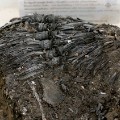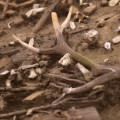History made: In an astonishing Bronze Age discovery a 3000-year-old community has been unearthed
Photos: Is this Britain's Pompeii?
An
archaeological dig in the Cambridgeshire Fens in England has discovered
a prehistoric settlement from the Bronze Age some 3000 years ago. The
site is called Must Farm.
Here, stones in the eastern area of the excavation are grouped around a palisade. It's a rather dense area of archeology with animal bone, timber debris and pot shards present.
Here, stones in the eastern area of the excavation are grouped around a palisade. It's a rather dense area of archeology with animal bone, timber debris and pot shards present.
Typically on prehistoric sites, you are
lucky to find a few pottery shards, a mere hint or shadow of organic
remains; generally archaeologists have to make do, have to interpret as
best they can.
But this archaeological dig has turned out to be completely, thrillingly different.
For the last ten months
-- day by day, week by week -- the excavation has yielded up a wealth
of astonishing finds including pottery, textiles, metal work and ancient
timbers. The dig offers, as site manager Mark Knight from the Cambridge
Archaeological Unit put it, "a genuine snapshot" of a lost world -- a
prehistoric settlement from the Bronze Age some 3000 years ago.
Bronze Age discovery: Is this Britain's Pompeii? 03:41
The
dig is almost without precedent the most revelatory of its kind in
Britain, if not in Europe, and it has already begun to transform our
knowledge of life in the Bronze Age.
Jointly
funded by the the government sponsored heritage organization, Historic
England and the managers of the clay quarry, Forterra, the dig has been
carried out under a large rectangular white tent -- about a thousand
meters square. It's the sort of tent you might use for a wedding
reception but here it's perched on the edge of a working quarry. Far
below, a big crane is busily extracting clay to make bricks.
The
archaeologists arrived in force last September and, protected from the
wind and rain under the tent, they've been forensically digging away
several meters below sea level. Interest was first aroused in 1999
when a series of wooden posts were discovered sticking out of the clay.
Trial excavations followed in 2004 and 2006 when Bronze Age spearheads
and a sword were found.
All very promising but still no one realized quite what they'd stumbled on.































History made: In an astonishing Bronze Age discovery a 3000-year-old community has been unearthed

Photos: Is this Britain's Pompeii?
A preserved Bronze-age sickle placed in protective material.
Hide Caption
6 of 10

Photos: Is this Britain's Pompeii?
The weaving process has been incredibly preserved, as can be seen with this bobbin.
Hide Caption
7 of 10

Photos: Is this Britain's Pompeii?
This bronze spear head was discovered with part of its shaft intact.
Hide Caption
8 of 10

Photos: Is this Britain's Pompeii?
The consistent design of these small clay pots suggests they were made by the same potter.
Hide Caption
9 of 10

Photos: Is this Britain's Pompeii?
This deer antler is still attached to part of the skull, indicating that it wasn't shed naturally.
Hide Caption
10 of 10

Photos: Is this Britain's Pompeii?
An
archaeological dig in the Cambridgeshire Fens in England has discovered
a prehistoric settlement from the Bronze Age some 3000 years ago. The
site is called Must Farm.
Here, stones in the eastern area of the excavation are grouped around a palisade. It's a rather dense area of archeology with animal bone, timber debris and pot shards present.
Here, stones in the eastern area of the excavation are grouped around a palisade. It's a rather dense area of archeology with animal bone, timber debris and pot shards present.
Hide Caption
1 of 10

Photos: Is this Britain's Pompeii?
In
the last 10 months, the excavation has yielded pottery, textiles, metal
work and ancient timbers -- like the exposed charred timbers seen among
archeologists working in the central area of the site.
Hide Caption
2 of 10

Photos: Is this Britain's Pompeii?
A Wilburton-type sword is seen with rivets and fragments of lead pommel.
Hide Caption
3 of 10

Photos: Is this Britain's Pompeii?
Weft
twining, made from flax, is a material rarely found in such good
condition from the period. It's considered a finding of international
importance.
Hide Caption
4 of 10

Photos: Is this Britain's Pompeii?
An artist's impression illustrates the layout of the original settlement.
Hide Caption
5 of 10

Photos: Is this Britain's Pompeii?
A preserved Bronze-age sickle placed in protective material.
Hide Caption
6 of 10

Photos: Is this Britain's Pompeii?
The weaving process has been incredibly preserved, as can be seen with this bobbin.
Hide Caption
7 of 10

Photos: Is this Britain's Pompeii?
This bronze spear head was discovered with part of its shaft intact.
Hide Caption
8 of 10

Photos: Is this Britain's Pompeii?
The consistent design of these small clay pots suggests they were made by the same potter.
Hide Caption
9 of 10

Photos: Is this Britain's Pompeii?
This deer antler is still attached to part of the skull, indicating that it wasn't shed naturally.
Hide Caption
10 of 10

Photos: Is this Britain's Pompeii?
An
archaeological dig in the Cambridgeshire Fens in England has discovered
a prehistoric settlement from the Bronze Age some 3000 years ago. The
site is called Must Farm.
Here, stones in the eastern area of the excavation are grouped around a palisade. It's a rather dense area of archeology with animal bone, timber debris and pot shards present.
Here, stones in the eastern area of the excavation are grouped around a palisade. It's a rather dense area of archeology with animal bone, timber debris and pot shards present.
Hide Caption
1 of 10

Photos: Is this Britain's Pompeii?
In
the last 10 months, the excavation has yielded pottery, textiles, metal
work and ancient timbers -- like the exposed charred timbers seen among
archeologists working in the central area of the site.
Hide Caption
2 of 10

Photos: Is this Britain's Pompeii?
A Wilburton-type sword is seen with rivets and fragments of lead pommel.
Hide Caption
3 of 10

Photos: Is this Britain's Pompeii?
Weft
twining, made from flax, is a material rarely found in such good
condition from the period. It's considered a finding of international
importance.
Hide Caption
4 of 10

Photos: Is this Britain's Pompeii?
An artist's impression illustrates the layout of the original settlement.
Hide Caption
5 of 10

Photos: Is this Britain's Pompeii?
A preserved Bronze-age sickle placed in protective material.
Hide Caption
6 of 10










Story highlights
- Must Farm is the site where an almost year-long archeological dig has been taking place
- The exploration has unearthed a well-preserved Bronze Age settlement and revealed incredible facts about a lost time
Cambridge, England (CNN)British archaeologists working on the Must Farm project in England's Cambridgeshire Fens can hardly restrain themselves.
Their online diary effervesces
with superlatives -- "truly fantastic pottery," "truly exceptional
textiles," "a truly incredible site," "the dig of a lifetime."
Typically
on prehistoric sites, you are lucky to find a few pottery shards, a
mere hint or shadow of organic remains; generally archaeologists have to
make do, have to interpret as best they can.
But this archaeological dig has turned out to be completely, thrillingly different.
For the last ten months
-- day by day, week by week -- the excavation has yielded up a wealth
of astonishing finds including pottery, textiles, metal work and ancient
timbers. The dig offers, as site manager Mark Knight from the Cambridge
Archaeological Unit put it, "a genuine snapshot" of a lost world -- a
prehistoric settlement from the Bronze Age some 3000 years ago.
The
dig is almost without precedent the most revelatory of its kind in
Britain, if not in Europe, and it has already begun to transform our
knowledge of life in the Bronze Age.
Jointly
funded by the the government sponsored heritage organization, Historic
England and the managers of the clay quarry, Forterra, the dig has been
carried out under a large rectangular white tent -- about a thousand
meters square. It's the sort of tent you might use for a wedding
reception but here it's perched on the edge of a working quarry. Far
below, a big crane is busily extracting clay to make bricks.
The
archaeologists arrived in force last September and, protected from the
wind and rain under the tent, they've been forensically digging away
several meters below sea level. Interest was first aroused in 1999
when a series of wooden posts were discovered sticking out of the clay.
Trial excavations followed in 2004 and 2006 when Bronze Age spearheads
and a sword were found.
All very promising but still no one realized quite what they'd stumbled on.






Comments